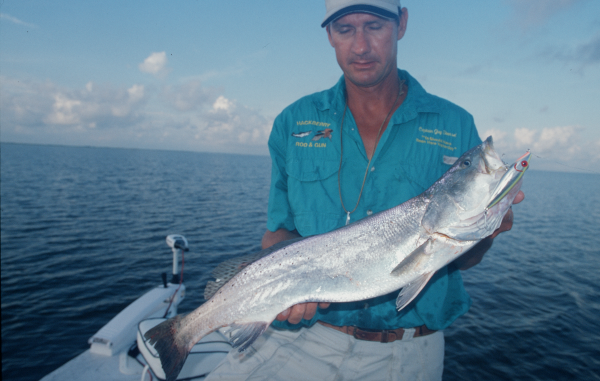
Stansel brothers share Big Lake knowledge
Calcasieu Lake definitely has an annual trout cycle, and few know it better than the co-owners of the Hackberry Rod and Gun Club.
In this excerpt from Trout Masters: How Louisiana Anglers Catch the Lunkers, Kirk, Guy and Bobby Stansel discusses tips and tactics to catch big speckled trout on Big Lake.
“Equipment is real important for big trout,” Kirk said firmly. “Big trout are real spooky, so you need a rod and reel that can cast long distances and cover more water. A good, smooth drag is essential, too.”
All three brothers typically spool their reels with 10- or 12-pound-test Trilene Big Game monofilament line, but they’re not averse to experimentation.
“Kirk is on a jag trying out 20-pound-test PowerPro braided line,” Guy said.
Typically, they use 3-foot shock leaders made of 20- to 25-pound-test Trilene Big Game line. Only when the water is very clear is fluorocarbon used as leader material.
In what seems to be a commandment to Big Lake trout fishermen, they stress the importance of keeping their reels spooled full of line. Line changes are made every 7-14 days.
Calcasieu Lake, at first glance, appears to be a big bowl with few features to a newcomer fisherman, but the Stansels said there is a lot to look for. According to Guy, the first decision to make will be based on which way the wind is blowing in the morning when you get up.
“You want clear water, so you look for lee shores,” he said.
They agreed that the best winds are light southeast breezes.
“Anything from north swinging to south, I like,” Kirk said.
West winds, they agreed are worst, because they muddy the water more than other winds do.
While the brothers fish all tides, they have definite opinions on them.
“You gotta have movement; it is very important,” Bobby said. “It can be incoming or outgoing, but you need movement.”
Kirk noted that he likes it best when the tide is moving and high, but not high enough to go over the marsh.
“Bait will run the shoreline under those conditions, and you can catch a lot of big trout in shallow water,” he said. “When the tide is low, trout will tend to be deeper, on reefs.”
Concerning tide range, Kirk said that the bigger the range is, the farther from the Ship Channel one should fish. He added that a rising tide is best in the spring and summer, and a falling tide is best in the fall and winter.
Then when you get on the water, you look for clarity and you look for bait activity. Guy and Bobby explained that the lake has a lot of ribbonfish in it, and when you see ribbonfish skipping across the water, you know that trout are chasing them. Lots of big trout are also taken under schools of small pogies.
Bobby divulged that one of his tricks for drawing strikes from big trout involves ladyfish.
“When a ladyfish takes a topwater bait, flip your reel to free-spool and let it run,” he suggested. “Big trout, as well as redfish, will take it.”
When the right water clarity and bait conditions are found, they will usually drift until they catch fish, then drop anchor. Trolling motors are used sparingly as the brothers believe they spook big trout.
“They didn’t get big by hanging around when they heard trolling motors,” Bobby said. “They spooked out.”
The brothers agreed that drifting oyster reefs is productive, but cautioned that Big Lake oyster reefs have very little profile. Since they seldom rise more than a foot off the bottom, they can be hard to find. Guy estimated that between 70 and 80 percent of their fishing is done by drifting over reefs.
“Fishing slicks is important too,” Bobby said.
They try to get upwind of slicks, and drift to them rather than run to them. But it is a game of chance. The boat may not drift right, the fish that made the slick may have swum off, or another species besides trout may have made the slick.
They note that fishing under diving sea gulls is more frustrating than it used to be. Years ago, you could move to the birds, anchor and catch fish. Now, even though there are a lot more birds than there used to be, you have to constantly move. The brothers pondered whether the fish schools are smaller or if the gulls or the trout are getting wiser.
Kirk, Guy and Bobby Stansel’s tips
1) Learn where the big fish hang out. Less than 10-25 percent of the water that holds trout will hold big trout.
2) Learn their seasonal movement patterns — in general, to the south in the summer and northward in the winter.
3) Fish quieter.
4) Use big lures.
5) Be flexible in your presentation. Constantly try different retrieval speeds and presentations.
6) If you suspect big fish are in an area, be patient. Don’t hesitate to come back to a spot three or four times in a day.
7) Use shock leaders. Treble hooks and teeth work on lines. Big fish stress line, as well.
8) It is especially important to find clear water.
9) Fish slicks because big trout tend to make slicks more than little trout.
10) Look for baitfish activity, the more the better.
11) Be lucky. Kirk quoted Sam Crutchfield, a retired charter captain from Florida: “Fishing is all luck, the harder you fish, the luckier you get.”
Learn more about how the best guides and anglers across the Louisiana coast catch trout day in, day out by purchasing the Trout Masters Tool Kit, which includes a special package price for Trout Masters: How Louisiana’s Best Anglers Catch the Lunkers and Trout Masters Too: How the Pros do it.


